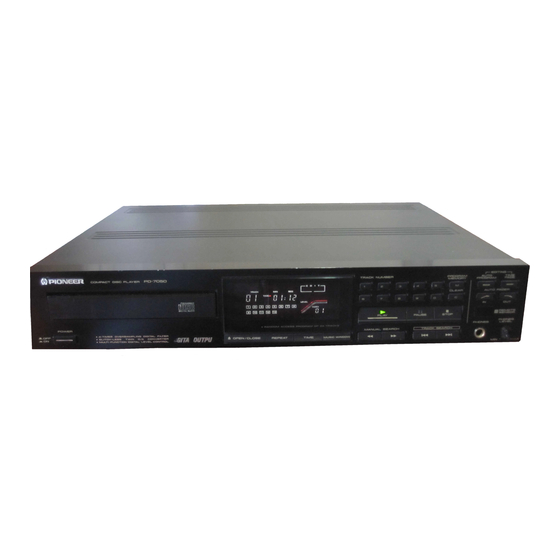Pioneer PD-6050 Instrukcja serwisowa - Strona 8
Przeglądaj online lub pobierz pdf Instrukcja serwisowa dla Odtwarzacz CD Pioneer PD-6050. Pioneer PD-6050 31 stron.

2. OPTICAL ! W H IN THE PICK-UP
2 4 OPTICAL PATH AND OPTICAL PARTS
2-2 FEATURE OF EACH PART
DISC
Half mirror
Objective lens
Reflecting mirror
Grating (diffraction grating)
Laser diode
Photo diode (with pre-amplifier)
Fig. 2-1 shows the configuration of
this pick-up's optical part
The wavelength of the light emitted from the laser diode is
between 780 and 790 nm. The light is barely visible. This
light source is spread into an ellipse from an ultra-small
emission point. The light expands at a set angle.
The emitted light goes through a grating and is divided into
three beams of 0 step and ±1 step.
The other beams of ±2, 3, and n steps are also present, but
are lost and not used. When the light reaches the half
mirror, 50% is reflected. The remaining light permeates the
half mirror and is lost.
The light then goes to the reflecting mirror where all the
light is reflected to the objective lens (finite type).
Since this pick-up's objective lens uses a finite system
(finite because the LD's convergence distance is finite), a
collimator lens is unnecessary. The old models objective
lenses are called infinite type. The light that is converged on
an ultra-small diameter spot by these objective lenses is
reflected by the disc and returns to the objective lens. Then
it goes through the half mirror where 50% of it returns to
the laser diode. The remaining 50% of light goes through
and reaches the photo diode.
This has been a general outline of the optical path. The
features of each part are explained in the following section.
+1 order
0 order
( A )
-1 order
Fig. 2-2
( B )
(1) Laser diode (LD)
The size of previously-used LDs was 90. However, a newly-
developed LD with a size of 5.60 has been introduced. This
has resulted in a compact and lightweight optical path.
(2) Objective lens
The collimator lens has been replaced by the finite objec-
tive lens which has a finite convergence distance for the
LD's optical path. This has resulted in lower costs while
preserving high performance.
The finite objective lens, like the conventional infinite lens,
is a high-performance lens designed to attain sufficient op-
tical performance even when the optical parts are not
parallel within the optical path.
(3) Half mirror
The light that returns to the objective lens goes through the
half mirror. Since the half mirror is a glass plate, it is known
that astigmatism is created for the light which enters at an
angle. The old model similarly used a glass plate and had a
device in its optical part to cancel this astigmatism.
Whereas, this new pick-up uses the astigmatism advantage-
ously for the focus servo.
Consequently, the multi-lens used in previous models has
not been incorporated in this new pick-up. This has resulted
in lower costs while preserving high performance. At the
same time, the points of parts have been reduced, improv-
ing dispersion and reliablity.
(4) Axle-sliding actuator
The position accuracy of the objective lens is an important
factor for the optical pick-up. The pick-up has a sliding axle
for the actuator which drives the objective lens. Accurate
and stable positioning of the objective lens is thus attained,
resulting in stable trackability. Also, a smooth frequency
response with low resonance is also realized as with the con-
ventional spring-supported type.
8
